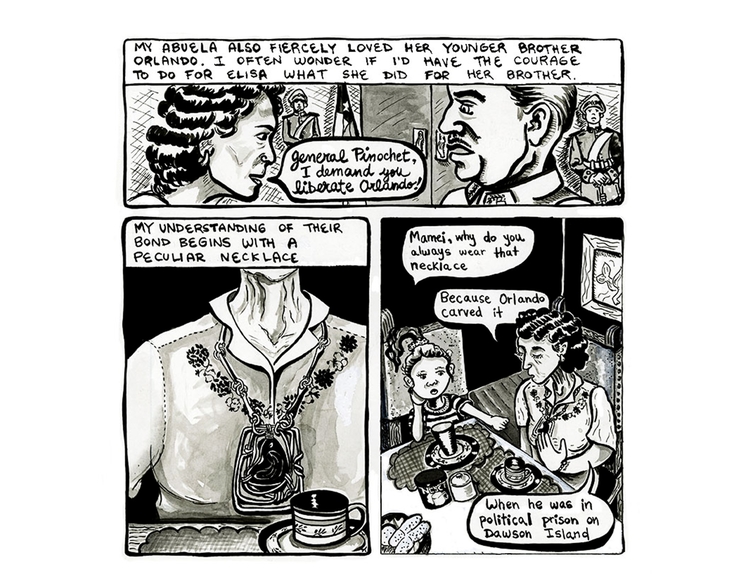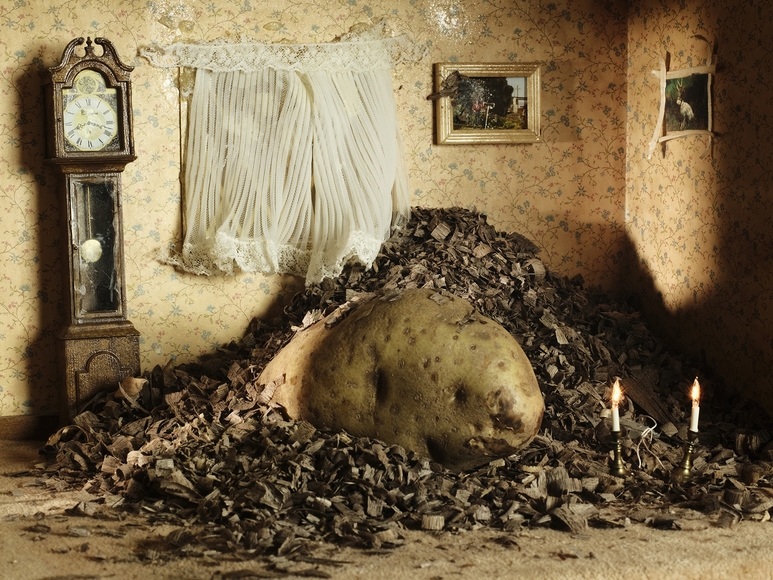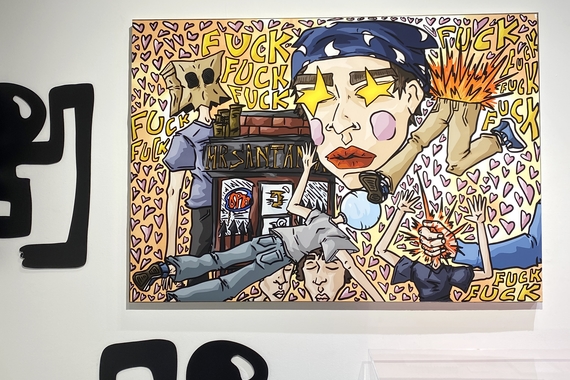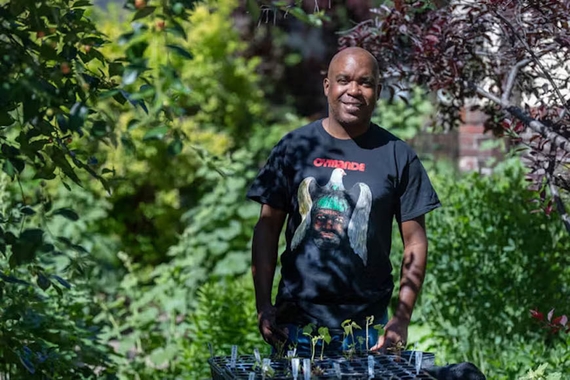lineage: 2023 MFA Thesis Exhibition
lineage
2023 MFA Thesis Exhibition
March 28 – April 15, 2023
Katherine E. Nash Gallery
Public Program & Reception: Saturday, April 1, 2023
Public Program | 6:00 - 6:30 PM | InFlux Auditorium
Reception | 6:30 - 8:30 PM | Regis East Lobby
The Katherine E. Nash Gallery at the University of Minnesota presents lineage, a group exhibition of four artists about to complete their Master of Fine Arts degree in the Department of Art at the University of Minnesota. The exhibition includes works by Olivia Gallenberger, Camila Leiva, Nik Nerburn, and Hawona Sullivan Janzen.
By molding and shaping clay as a form of somatic release, Gallenberger uses ceramics as a surrogate for her body. Drawing from her familial archive, Leiva combines larger than life graphic novel spreads, textiles, and found objects to create an intimate and complex portrait of her grandmother. Nerburn constructs images and objects of whimsy and catastrophe using a regional vernacular of specific handicrafts. Informed by her multifaceted ancestral ties, Sullivan Janzen creates spaces, photographs, and experiences that unpack one’s ties to place and kin.
Learn more about each artist below:
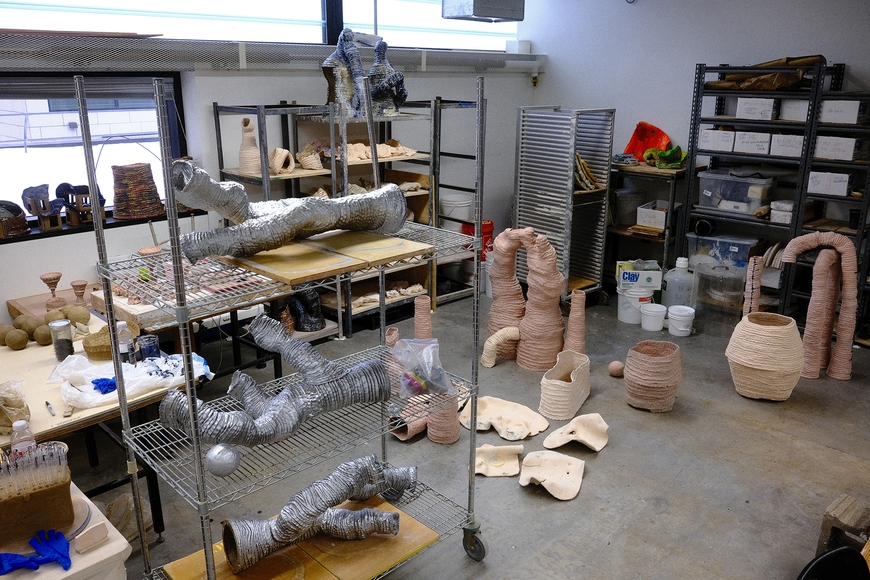
Olivia Gallenberger
Olivia Gallenberger (they/she) is a visual artist based in Minneapolis. She is a teaching artist at Northern Clay Center and Foci Minnesota Center for Glass Arts. Their multidisciplinary practice explores themes of memory loss, psychiatric care, medical violation, and familial relationships. Their interest in science fiction as a means of escapism seeps into the work via alternative fictions of the body. Gallenberger investigates the color blue as material and metaphor while considering how predisposed obsession affects the intersection between life and art. She is currently fascinated by the concept of portals and wormholes, what travels through them and what lies beyond them.
oliviagallenberger.com • Instagram: @oliviaoverboard
Artist Statement
Past, present and future are in a state of constant flux.
Art is a prophetic way of unknowingly telling the future.
Reliving past experiences and fighting present demons.
My body is no longer what it once was. Mourning my former self.
I have to navigate my body and my relationship with art in a new way.
Rebuilding the muscles in my leg and foot so that I can walk.
Clay, fiber, and photography help me travel through an unknown portal.
To reimagine my ideas of a studio practice.
I am reclaiming my body through the somatic experience of making.

Camila Leiva
Camila Leiva (B. 1987) is a transnational Chilean and U.S. American artist and educator whose body and soul are often seen traveling between Minneapolis and Santiago. Her life has been shaped by brave and loving women, especially by her grandmothers and her mother. She grew up in the visual, musical, and literary culture of Chilean social movements for justice, during the final years of the Pinochet dictatorship and in its neoliberal aftermath. She paints community murals, hand-draws comics, sews textile arpilleras and molds earthenware clay. She is razor-focused on telling the unknown story of her grandmother Fabiola Letelier, Chile’s most dogged human rights lawyer. Her work explores themes of memory, histories from below, and questioning the public versus private dichotomy imposed on women’s lives.
camilaleiva.com • Instagram: @camilalei_
Artist Statement
Trae una flor, un poema, una cancion / Bring a flower, a poem, a song is an invitation to learn about an extraordinary and imperfect woman named Fabiola, and the implications of growing up as her granddaughter. At the heart of the work is a graphic novel, told in first person narrative by the artist, that mixes archival research, family stories, and childhood memories. Hand drawn ink comic pages are enlarged, deliberately merging the art forms of muralism and comics, whose origins lie in democratizing the storytelling of the subaltern. Polychrome clay figurines emerged as a tactile way to process the painful family stories of dictatorship, and turn them into carnivalesque protest scenes reflecting the tradition of marching in the streets of Santiago. Finally, a Chilean textile form, known as an arpillera, transforms the inherited pieces of Fabiola’s old clothes into a portrait imbued with memory.

Nik Nerburn
Born in Bemidji, Minnesota, Nik Nerburn’s cross-disciplinary photographs, videos, and sculptures reflect his passion for people’s histories and stories from places that are “off the map.” His wide-ranging work addresses urgent subjects like toxic masculinity and the rural-urban divide, while also centering craft, generosity, trust, and humor. Informed by the collaborative traditions of puppetry and documentary filmmaking, Nerburn works with amateur genealogists, community archivists, neighborhood clubs, small town philosophers, and little museums.
niknerburn.com • Instagram: @datanodata
Artist Statement
Nik Nerburn’s current body of work tends to personal and familial stories, using regional vernacular artistic forms like yard art, model making, dollhouses, and tramp style wood carving. His photographs reveal miniature domestic spaces unraveling by way of personal and mythological disaster. Mostly composed inside of dollhouses, his photographic tableaus embody precariousness and turmoil rather than the dollhouse's middle class ideal. Using traditional processes such as whittling, chip-carving, frame making, and metal casting, Nerburn braids narratives of both whimsy and catastrophe. This is where a giant secret lives in a tiny house, stuck like a piano you can't fit out the door.
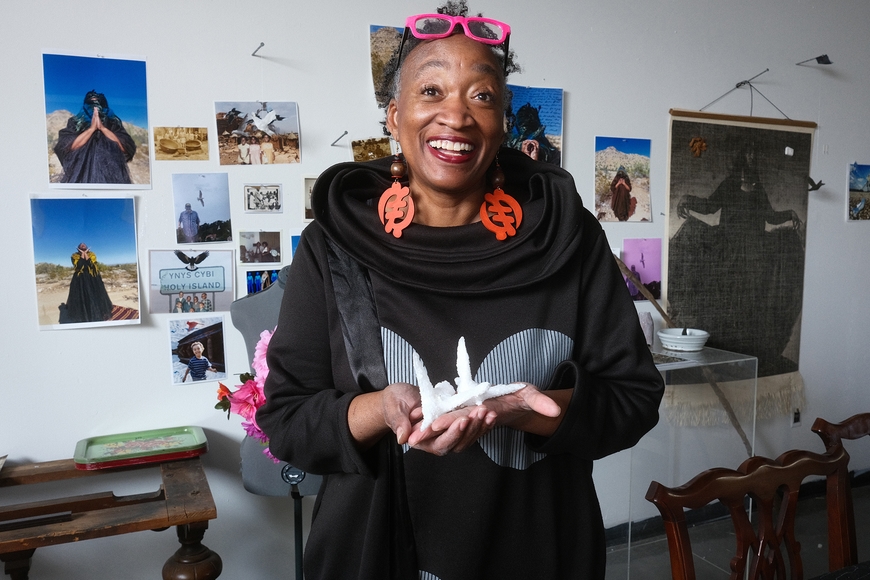
Hawona Sullivan Janzen
Hawona Sullivan Janzen is a Saint Paul-based social practice and visual artist whose work explores the intersections of grief, loss, love and hope. A 2020 Jerome Foundation Naked Stages Fellow, Hawona has received funding from the Minnesota State Arts Board, the National Endowment for the Arts, Metropolitan Regional Arts Council, the McKnight Foundation, and the Visual Arts Fund in support of The Andy Warhol Foundation for the Visual Arts. Her writings have been read on National Public Radio, featured in 10-foot-tall broadsides, performed as a jazz opera, and produced as a play at Pillsbury House Theatre. Her recent projects include the co-design of Saint Paul’s Dale Street Bridge over I-94 and Love Letters for the Midway — a crowdsourced poem printed onto lawn signs.
Instagram: @hawonawrites
Artist Statement
i am the black-white.
the descendant of
the enslaved and
enslavers.
both torn open. let me be
the salve: the thread
that seals these wounds.
The images, performances, and poetry in this work are the result of a journey through dream-conjure, and acts of divination. According to my dna profile, the blood of more than seventeen nations swirls in my veins. After discovering this I began to ponder who I really am physically, genetically, artistically, and spiritually versus who I might have been had my ancestors lived solely in one of these landscapes. I seek to explore how each of those cultures may manifest itself in me. Using real-altered photos and images from travel to several of my ancestral homelands, I began creating digital collages that seem to be a path to answers. May my journey inform and illuminate the path for any who follow.
The Katherine E. Nash Gallery spans 5,000 square feet for the presentation of exhibitions and related programming that engage with a wide range of artists, scholars, and collaborative partners.
Location & Hours
Regis Center for Art (East)
405 21st Avenue South
Minneapolis, MN 55455
Access the gallery via the Regis Center for Art main entrance. Plan to call upon arrival if the entrance is locked: 612-624-7530.
Tuesday and Friday, 11 am – 5 pm
Wednesday and Thursday, 11 am – 7 pm
Saturday, 11 am – 3 pm
Contact Us
Gallery Attendant Desk
612-624-7530
Administrative Office
nashgallery@umn.edu
Parking & Public Transit
Learn more about the parking options below:
21st Avenue South ramp
5th Street South lot
19th Avenue South ramp
The Gallery is accessible via Metro Transit buses and light rail lines. For your best route, visit Metro Transit Trip Planner.
Accessibility
Regis Center for Art is accessible to visitors who use mobility devices or prefer to avoid stairs. Service animals are welcome in the gallery.
A fully accessible, gender neutral restroom is available on the 2nd floor of the Regis Center for Art (West). To access this restroom, take the elevator to the 2nd floor and proceed across the skyway towards Regis West. As you exit the skyway the restroom will be directly across from you. Fully accessible gendered restrooms are located directly to the left hand side when exiting the gallery on the first floor of Regis Center for Art (East).
Large bags and backpacks must be left at the gallery front desk with the attendant. In order to protect the art, no food or drink is allowed in the gallery.
May 2 - 13, 2023
BFA Thesis
Friday, May 5
Public Program | 6:00 - 6:30 PM | InFlux Auditorium
Public Reception | 6:30 - 8:00 PM | Regis East Lobby
January 17 - March 18, 2023
A Tender Spirit, A Vital Soul
September 13 - December 10, 2022
A Picture Gallery of the Soul
January 21 - March 28, 2020
The Beginning of Everything
September 10 – December 7, 2019
Queer Forms
September 15, 2015 - January 27, 2019
Covered in Time and History: The Films of Ana Mendieta
Katherine E. Nash Gallery | September 15 - December 12, 2015
NSU Art Museum | February 28 - July 3, 2016
BAMPFA | November 9, 2016 - January 15, 2017
Bildmuseet | June 18, 2017 - October 22, 2017
Martin-Gropius-Bau | April 20 - July 22, 2018
JeMiiu de Paume | October 16, 2018 - January 27, 2019
Mission
The Katherine E. Nash Gallery is a research laboratory for the practice and interpretation of the visual arts.
Vision
We believe the visual arts have the capacity to interpret, critique, and expand on all of human experience. Our engagement with the visual arts helps us to discover who we are and understand our relationships to each other and society.
The Katherine E. Nash Gallery will be a center of discourse on the practice of visual art and its relationship to culture and community — a place where we examine our assumptions about the past and suggest possibilities for the future.
The Nash Gallery will play an indispensable role in the educational development of students, faculty, staff, and the community.
History
Professor Katherine "Katy" E. Nash (1910–1982), a faculty member of the Department of Art from 1961–1976, proposed that the Student Union create a university art gallery. Founded in 1979, the gallery moved to its current location in the Regis Center for Art in 2003. Learn more about the remarkable life and work of Professor Nash.

